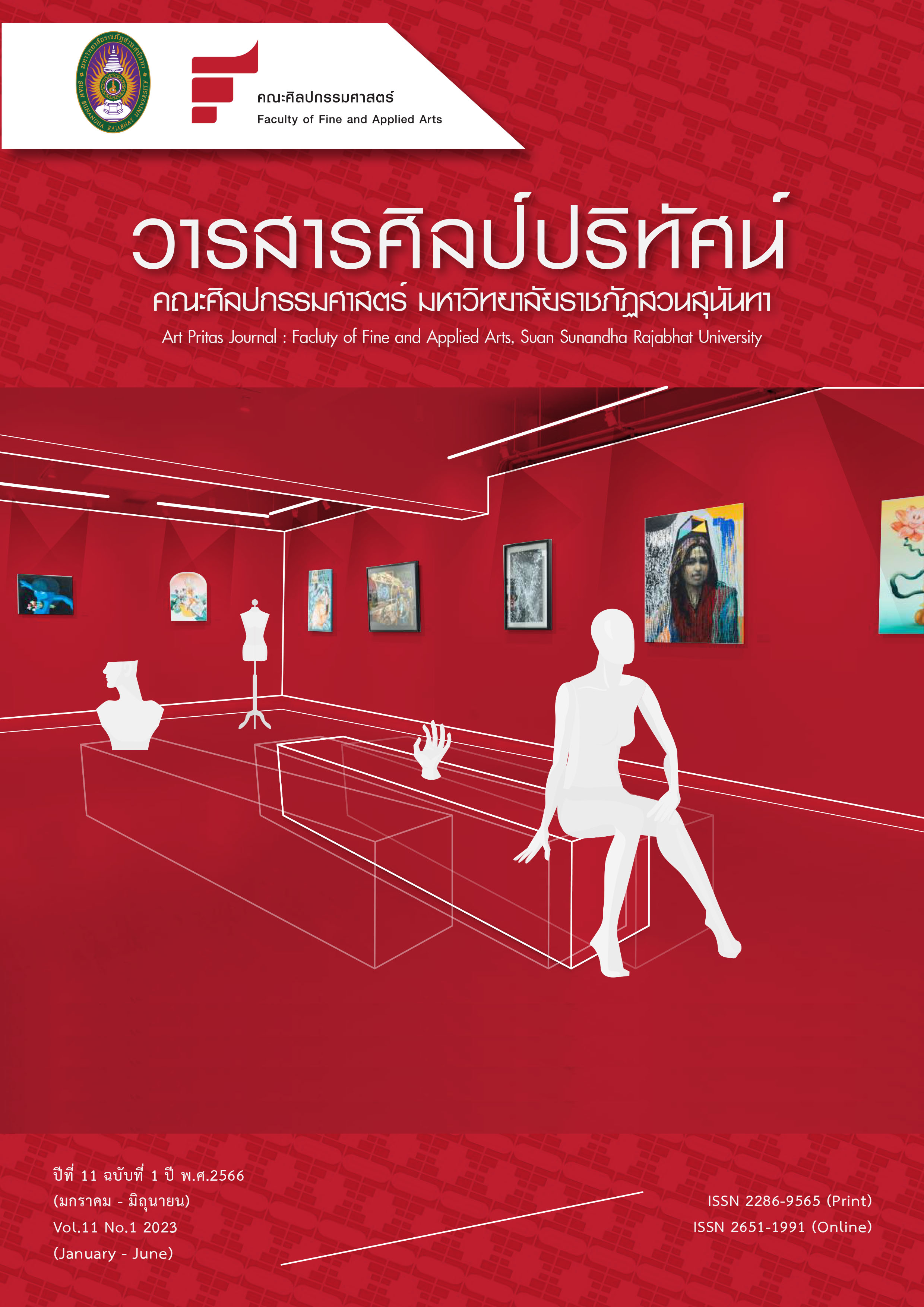การเปลี่ยนผ่านจากครูเป็นจุดศูนย์กลางสู่นักเรียนเป็นจุดศูนย์กลางวิชาทักษะคีย์บอร์ด ด้วยการประเมินตนเอง
Main Article Content
บทคัดย่อ
วิชาทักษะคีย์บอร์ดเป็นวิชาบังคับให้นักศึกษาสาขาวิชาเอกดนตรีในระดับอุดมศึกษา โดยมุ่งหวังให้นักศึกษานำความรู้และทักษะคีย์บอร์ดไปใช้ในกิจกรรมทางดนตรีอื่น ๆ การสอนอยู่ในรูปแบบกลุ่ม โดยครู 1 คน ต่อจำนวนนักศึกษาจำนวน 10-15 คน รูปแบบการเรียนการสอนอยู่ในรูปแบบที่ “ครูเป็นจุดศูนย์กลาง” โดยครูสอนเป็นผู้เลือกความรู้ สาธิต อธิบายและให้นักศึกษาไปฝึกปฏิบัติ การสอนรูปแบบดังกล่าวส่งผลต่อนักศึกษาที่มาจากหลายเครื่องมือเอก รวมทั้งวิชามีเนื้อหาที่กว้าง หลากหลายและต้องใช้เวลาจึงจะมีความทักษะคีย์บอร์ดความสามารถตามที่หลักสูตรกำหนด ทำให้นักศึกษาส่วนหนึ่งไม่สามารถบรรลุตามวัตถุประสงค์ที่ตั้งไว้ ซึ่งปัญหาหนึ่งเกิดจากรูปแบบวิธีการสอน การเปลี่ยนผ่านจากครูเป็นจุดศูนย์กลางมาเป็นการใช้การประเมินตนเองที่เน้นผู้เรียนเป็นจุดศูนย์กลาง ด้วยวิธีการดังกล่าวช่วยให้นักศึกษาได้เข้าใจว่า ตนเองต้องเรียนอะไรบ้าง สามารถจัดลำดับความสำคัญ สามารถออกแบบการเรียนรู้ จากการประเมินตนเองที่ดี ทำให้ผู้เรียนรับรู้ถึงข้อดี ข้อบกพร่อง และมีแรงจูงใจในการนำข้อบกพร่องไปแก้ไข้ ด้วยการปรับปรุงการปฏิบัติทักษะคีย์บอร์ดในระหว่างเรียน (formative assessment) ช่วยให้นักศึกษาบรรลุวัตถุประสงค์ตามที่รายวิชาได้กำหนดไว้
Article Details

อนุญาตภายใต้เงื่อนไข Creative Commons Attribution-NonCommercial-NoDerivatives 4.0 International License.
เนื้อหาและข้อมูลในบทความที่ลงตีพิมพ์ในวารสารศิลป์ปริทัศน์ ถือเป็นข้อคิดเห็นและความรับผิดชอบของผู้เขียนบทความโดยตรง ซึ่งกองบรรณาธิการวารสารไม่จำเป็นต้องเห็นด้วย หรือร่วมรับผิดชอบใดๆ
บทความ ข้อมูล เนื้อหา รูปภาพ ฯลฯ ที่ได้รับการตีพิมพ์ในวารสารศิลป์ปริทัศน์ถือเป็นลิขสิทธิ์ของวารสารศิลป์ปริทัศน์
เอกสารอ้างอิง
ทิศนา แขมณี. (2548). ศาสตร์การสอน: องค์ความรู้เพื่อการจัดกระบวนการเรียนรู้ที่มีประสิทธิภาพ (พิมพ์ครั้งที่ 4). กรุงเทพ ฯ : ศูนย์หนังสือแห่งจุฬาลงกรณ์มหาวิทยาลัย.
สำนักงานราชบัณฑิตยสถาน. (2558). พจนานุกรมศัพท์การศึกษาศาสตร์ร่วมสมัย ฉบับราชบัณฑิตยสภา. กรุงเทพฯ: สำนักงานราชบัณฑิตยสถาน
Andrade, H. (2019). A Critical Review of Research on Student Self-Assessment. Front Educ. Retrieve from https://www.frontiersin.org/articles/10.3389/feduc.2019.00087/full.doi: 10.3389/feduc.2019.00087
Andrade, H., and Y. Du. (2007). Student Responses to Criteria-referenced Self- Assessment. Assessment & Evaluation in Higher Education 32 (2): 159–181. DOI: 10.1177/0027432111434742
Andrew, D. Christopher. (2016). Student Self-Assessment: Teacher’s Definitions, Reasons, and Beliefs. All thesis and Dissertation. 6393. BYU Scholars Archive Retrieve from http:// scholarsarchive.byu.edu/etd.
Cowan, J. (2006). On becoming an innovative university teacher: Reflection in action. 2nd.ed. Oxford: Oxford University Press.
Elliott, David J. and Silverman, Marissa. (2014). Music Matters: A Philosophy of Music Education 2nd Edition. NY: Oxford University Press.
Green, Lucy. (2008). Music, Informal Learning and the School: A New Classroom Pedagogy. NY: Ashgate Publishing Ltd.
Hallam, Susan. (2006). Music Psychology in Education. London: Institute of Education, University of London.
Moss, M. Connie and Brookhart M. Susan. (2009). Advancing Formative Assessment in Every Classroom: A Guide for Instructional Leaders. VA: ASCD Publishing.
National Association of Schools of Music. (2020). National Association of Schools of Music Handbook 2019-20. VA: The National Association of Schools of Music
Rosenshine, Barak. Froehlich, Hidegard and Fakhouri Inshad. (2002). The New Handbook on Music Teaching and Learning. A Project of the Music Education National Conference. Richard Colwell and Carol Richardson Editor. NY: Oxford University Press.
Scott, Sheila. (2012) Rethinking the Roles of Assessment in Music Education. Music Educators Journal, 98(3), 31-35.
Taras, M. (2010). Student self-assessment: processes and consequences. Teaching in Higher Education, 15(2), 199-209.
Wride, Michael. (2017). Guide to Self-Assessment; Academic Practice and e-learning (CAPSL) resourced assessment. University of Dublin Trinity College. Retrieved fromhttps://www.tcd.ie/CAPSL/resources/assessment/selfassessment.php
Yan, Zi and Brown T.L. Gavin. (2017). A cyclical self-assessment process: towards a model of how students engage in self-assessment, Assessment & Evaluation in Higher Education, 42:8, 1247-1262, DOI: 10.1080/02602938.2016.1260091
Young M. Margaret. (2013). University-level group instruction and professional musicians, Music Education Research, 15:1, 59-73.


